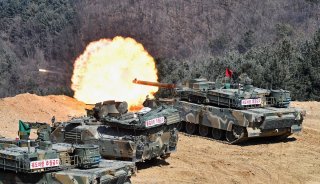You're Dead: 4 Most Powerful Tanks on the Battlefield Today
These tanks come from Russia, the United States, Germany, and South Korea, and they represent what are arguably the four best tanks in active service. Here’s why.
These tanks come from Russia, the United States, Germany, and South Korea, and they represent what are arguably the four best tanks in active service. Here’s why.
Leopard 2 A7+
The newest Leopard variant could arguably be Europe’s best tank. The platform first came to life in West Germany during the 1970s, and since its introduction into the German Bundeswehr, has steadily incorporated improvements to its armor protection. It is currently in service with several NATO countries, including the Netherlands, Austria, and Canada — a testament to the German tank’s superior qualities.
Although German armored vehicles do not incorporate depleted uranium into their armor protection due to domestic political sensitivities associated with nuclear power and related materials, the Leopard nonetheless benefits from passive all-around protection. Like most NATO main battle tanks, the Leopard II also fire 120mm ammunition, though the manufacturer claims that the Leopard can fire “programmable detonation ammunition” which can detonate in the air in front of or above targets as far away as 5,000 meters.
M1 Abrams
The United States’ main battle tank may well be one of the best-protected tanks in the world thanks to extensive use of very dense depleted uranium armor protection on the hull and turret. The Army is currently experimenting with an Israeli active protection system which might be incorporated on all Army tanks in the future and offer the Abrams even better protection.
The Abrams could also very well be one of the most battle-tested main battle tanks currently in active service and has proven itself to be a valuable armored platform. Like most MBTs, the Abrams fires a 120mm projectile, but one of the tanks' persistent problems has been its steadily increasing curb weight. Thanks in part to its heavy depleted uranium protection (DU is 1.67 times denser than lead), the M1 weighs in excess of 70 tons — a weight issue that severely complicates the tank's logistics and might actually hinder the Abrams’ combat effectiveness, well-protected though it may be.
K2 Black Panther
This might just be the most expensive tank you’ve never heard of. South Korea’s K2 is technologically sophisticated and incorporates a number of features that optimize the armored platform for fighting on the Korean Peninsula’s hilly and swampy terrain. The K2’s hydraulic suspension is able to tilt the Black Panther in a variety of directions. For better cross-county performance, the suspension is raised, and on roads, lowered. However, the tank can also “kneel” forward, or “lean” backward, allowing the tank to more easily fire upwards at targets positioned high up on hills or low mountains, and conversely to fire downward at targets in valleys.
Though the Black Panther’s engine is a fairly standard 1,500 horsepower engine, the K2’s low weight makes it quite nimble. Combined with an extendable snorkel, and the ability to take on 500 gallons of water ballast, the K2 can ford bodies of water that are over 13 feet deep — and go virtually anywhere in Korea.
T-14 Armata
Though Russia revealed their newest T-14 Armata tank to great fanfare during the 2015 Victory Day Parade in Moscow, the tank has been produced in only very small numbers. Still, the tank has several unique features that would make it a force to be reckoned with on the battlefield. One of the Armata’s more unique characteristics is its 1,500 horsepower engine. While 1,500 horsepower is the standard engine output, the T-14 is able to briefly boost its engine output by a third to 2,000 horsepower. This comes at a cost to engine longevity, however.
One of the other touted aspects of the Armata is its overlapping active and passive protection system that combines Malachit explosive-reactive armor panels, with Russia’s Afghanit active protection system, which some commentators have speculated could effectively destroy even the most advanced anti-tank munitions.
Caleb Larson is a Defense Writer with The National Interest. He holds a Master of Public Policy and covers U.S. and Russian security, European defense issues, and German politics and culture.

